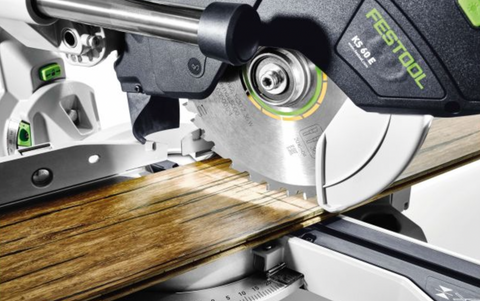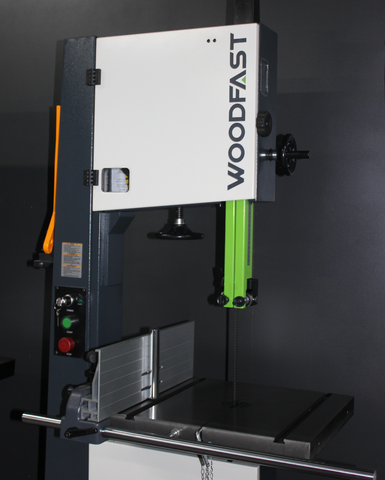Imagine a time when saws were not the common household tools we know today. It’s hard to fathom, right? Saws have come a long way over the years, evolving to become the versatile and efficient tools we rely on for various tasks.
From the early days when manual saws were king to today's powerful electric machines, the choices can be overwhelming at times. With so many types of saws available, and limited workshop space, it's challenging to determine which one is right for your workshop. That's why we're here to dive deep into two of the heavyweights: the bandsaw and the table saw. We'll explore each saw's features, capabilities, and benefits, allowing you to make an informed decision to suit your woodworking needs.
The Quick Comparison:
Bandsaws use continuous blades for cutting straight, curved or irregular shapes.
Table saws utilise circular teethed blades better suited for perfectly straight cuts.
Table Saw Overview

The table saw reigns as the most widely used saw in woodworking, renowned for its precision and versatility. Available in contractor, cabinet, and hybrid models, each style offers unique features catering to many different needs. Contractor models are portable and affordable, ideal for DIYS, while cabinet models deliver more power and faster blade speeds, ideal for professionals. Hybrid models blend portability with power, appealing to a wide range of users.
Table saws have many advantages over other types of saws. For instance, no other tool can match a table saw's capacity to accurately handle long boards or cut compound angles. Table saws also come with various accessories such as miter gauges, precision fences, jigs and more, so endless options are available when it comes to detailed cuts.
Table saws take up more space in a workshop than bandsaws do and can be difficult for a beginner to setup safely. Furthermore, due to their size and powerful blades table saws can be incredibly loud — something that must always be taken into account when deciding which type of tool is right for you.
Despite these shortcomings, table saws are still an invaluable tool thanks to their unbeatable accuracy and power — two qualities that make them ideal for furniture makers and woodworking professionals looking for perfection from their projects. With the proper knowledge and skillset it’s easy to harness their potential for satisfying results.
Advantages of Table Saws:
- Superior for straight cuts
- Achieves extremely clean cuts
- Ideal for sizing and squaring manmade materials such as MDF, Plywood Melamine etc.
- Excellent for accurate beveled, mitred, and compound cuts
- Easy blade change and maintenance
- Offers various accessories for precision cutting & repeatability
Disadvantages of Table Saws:
- Incapable of cutting curves
- Limited cutting depth
- Requires significant floorspace
- Rotating blade makes them more hazardous if not properly operated
Main Summary Points:
When comparing power tools, table saws are typically much more powerful than bandsaws and are better for cutting through hardwood. Bandsaws are better for accuracy when cutting curves and circles but can be used for short rip cuts in thin stock as well. Both tools offer enough power for general woodworking purposes, and the best one to choose depends on the type of projects being worked on and level of experience of the user.
Bandsaw Overview

The bandsaw's versatility is seen in its compact design and endless loop of serrated blades rotating around wheels. Bandsaws are favoured in workshops due to its ability to cut curved and irregular cuts.
Bandsaws are generally regarded as safer than a table saw, but a moving blade on any machine MUST be taken seriously. Bandsaws generate noise while cutting, but can be almost silent between cuts. Their blade can be just as dangerous as a spinning table saw blade, but with less chance of kickback.
The bandsaw’s much larger cutting depth and their ability to cut curves and irregular shapes, tapers and fairly good straight lines, makes them one of the most popular and versatile machines in the workshop today.
A Bandsaw is generally used on larger stock, for bringing the dimensions of the timber down into usable board widths and thicknesses. They are measured by their cut depth capacity, and their ripping capacity from the blade to the upright column.
Compared to a table saw, the thinner Bandsaw blade makes for a less accurate cut, with a cut surface that needs cleaning later on either a table saw, thicknesser or jointer.
Advantages of Bandsaws:
- Capable of both straight and curved cuts
- Ideal for resizing material before planing
- Offers deep cutting depth
- Less force directed toward the user
- Wide variety of blade options
- Requires less floorspace
Disadvantages of Bandsaws:
- Cut finish not as refined as table saws
- Blade may wander during straight cuts
- Slow blade change process
- Less accurate for repeat cuts
So, which one should you buy?
Many workshops will include both machines as they both offer unique features. But which one do you buy first? It all comes down to which one suits your current and short-term future needs the best.
If space is a consideration and you are planning on working on curved projects, then a bandsaw should be considered first, however if you have the space and are wanting clean, accurate straight cuts, or to work with sheet type products, then a table saw should be your #1 choice.

















